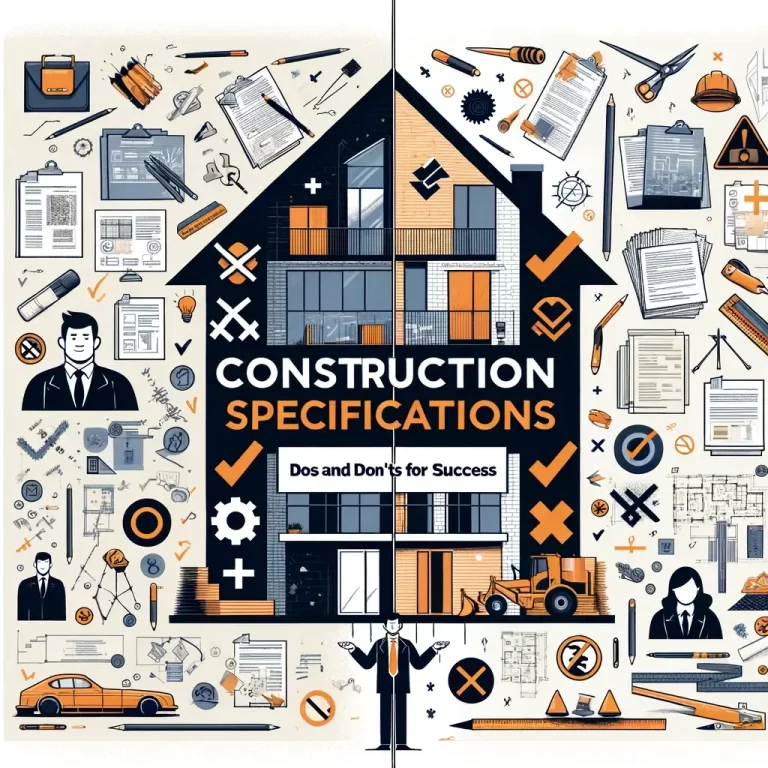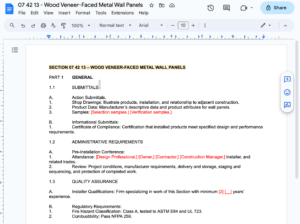Mastering Specifications in Construction: Dos and Don’ts for Success
Are you struggling to navigate the world of construction specifications? You’re not alone. Mastering the intricacies of this crucial aspect of the construction process can be a daunting task. But fear not, because we’re here to help you become a specifications guru.
In this article, we’ll provide you with the dos and don’ts for success when it comes to construction specifications. Whether you’re a seasoned contractor or a newcomer to the industry, these valuable tips will help you streamline your projects, avoid costly mistakes, and ensure that your specifications are accurate, comprehensive, and effective.
From understanding the importance of clear and concise language to avoiding common pitfalls and ensuring compliance with industry standards, we’ll cover it all. We’ll also delve into the best practices for organizing, formatting, and presenting construction specifications to optimize efficiency and maximize comprehension.
So, if you’re ready to take your construction projects to the next level, join us as we unravel the dos and don’ts of mastering construction specifications. Get ready to enhance your project management skills and set yourself up for success in the competitive construction industry.
Importance of construction specifications
Construction specifications play a vital role in ensuring that construction projects are executed smoothly and according to plan. They serve as the foundation for communication between the project team, including architects, engineers, contractors, and suppliers. Clear and well-defined specifications help everyone involved understand the project requirements, materials, methods, and standards.
Having accurate and detailed construction specifications is crucial for several reasons. First, they provide a clear roadmap for the project, outlining the scope of work and the quality standards to be met. This helps prevent misunderstandings and ensures that all parties are on the same page. Specifications also help control costs by specifying the materials and methods to be used, preventing expensive deviations. Additionally, they serve as a reference for inspections and quality control, ensuring compliance with regulatory requirements.
Common mistakes in construction specifications
Creating construction specifications is not without its challenges. There are some common mistakes that can lead to confusion, delays, and costly rework. One of the most common mistakes is using vague or ambiguous language. Specifications should be precise and clear, leaving no room for interpretation. Vague language can lead to misunderstandings, disputes, and delays in the construction process.
Another mistake to avoid is failing to update specifications when changes occur. Construction projects are dynamic, and changes are inevitable. Failing to update specifications to reflect these changes can lead to confusion and errors. It’s important to maintain accurate and up-to-date specifications throughout the project.
Inconsistencies and contradictions are also common pitfalls. Specifications should be internally consistent and align with other project documents such as drawings and contracts. Inconsistencies can result in conflicts and delays, as well as compromise the quality and safety of the project.
Dos for creating effective construction specifications
To create effective construction specifications, there are several dos to keep in mind. First and foremost, use clear and concise language. Specifications should be written in a way that is easily understood by all project stakeholders. Avoid technical jargon and industry-specific acronyms unless necessary, and define any terms that may be unfamiliar to the reader.
Another important aspect of effective specifications is ensuring they are comprehensive. They should cover all aspects of the project, including materials, methods, quality standards, and installation requirements. Include detailed information about the materials to be used, such as manufacturer’s specifications, product approvals, and testing requirements. This will help ensure that the right materials are used and that they meet the necessary standards.
Consistency is key when it comes to construction specifications. Use consistent terminology and formatting throughout the document. This will make it easier for readers to navigate and understand the specifications. Consistency also extends to referencing other project documents, such as drawings and contracts. Ensure that specifications align with these documents to avoid conflicts and confusion.
Understanding different types of construction specifications
Construction specifications come in various forms, and it’s important to understand the different types and when to use them. The two main types of specifications are prescriptive and performance specifications.
Prescriptive specifications provide detailed instructions on how to achieve the desired result. They specify the materials, methods, and quality standards to be followed. Prescriptive specifications are commonly used when there is a clear and established method for achieving the desired outcome.
Performance specifications, on the other hand, focus on the desired result rather than the specific means of achieving it. They outline the performance requirements and leave it up to the contractor to determine the best way to meet those requirements. Performance specifications are often used when there are multiple acceptable methods or when innovation is desired.
Understanding the differences between these types of specifications will help you determine which approach is most appropriate for your project.
Key components of a construction specification document
A well-written construction specification document consists of several key components. These components provide detailed information about the project requirements and help ensure that all parties involved have a clear understanding of what is expected.
The first component is the general requirements section, which outlines the overall project requirements, including scope, schedule, and quality standards. This section sets the foundation for the rest of the specifications.
Next is the materials section, which provides detailed information about the materials to be used in the project. This includes specifications for each material, such as type, size, grade, and performance requirements. It may also include information about the source of the materials and any testing or approval processes they must undergo.
The methods section describes the processes and techniques to be used in the construction project. It outlines the step-by-step procedures for various tasks and may include diagrams, illustrations, or references to industry standards.
The last component is the quality control section, which outlines the requirements for inspections, testing, and quality assurance. This section ensures that the project meets the necessary quality standards and regulatory requirements.
Best practices for organizing and structuring construction specifications
Organizing and structuring construction specifications is essential for optimizing efficiency and maximizing comprehension. Following best practices in this area will help ensure that your specifications are easy to navigate and understand.
Start by creating a logical and intuitive structure for your specifications. Divide the document into sections and subsections, each focusing on a specific aspect of the project. Use clear headings and subheadings to guide readers and make it easy for them to find the information they need.
Within each section, organize the information in a logical order. This could be chronological, based on the construction sequence, or by grouping related tasks or materials together. Use bullet points or numbered lists to break down complex information into digestible chunks.
Formatting is crucial for readability. Use consistent formatting throughout the document, including font styles, sizes, and spacing. Consider using tables, charts, or diagrams to present information in a visually appealing and easily understandable way.
Lastly, make sure to review and proofread your specifications before finalizing them. Check for any errors, inconsistencies, or omissions. It’s also helpful to have someone else review the document to ensure clarity and accuracy.
Tools and software for creating and managing construction specifications
In today’s digital age, there are numerous tools and software available to assist in creating and managing construction specifications. These tools can streamline the process, improve collaboration, and enhance accuracy.
One popular tool is Building Information Modeling (BIM) software. BIM allows for the creation of detailed 3D models that can be linked to construction specifications. This integration ensures that the specifications are aligned with the design and can help detect clashes or conflicts early on.
Specification management software is another valuable tool. These software solutions provide a centralized platform for creating, organizing, and managing specifications. They often include features such as version control, collaboration tools, and integration with other project management software.
Cloud-based platforms are also gaining popularity in the construction industry. These platforms allow for real-time collaboration, document sharing, and accessibility from any device or location. They provide a secure and efficient way to create, store, and update construction specifications.
Conclusion: Steps to improve your construction specifications
Mastering construction specifications is a journey that requires continuous improvement and learning. To enhance your specifications and set yourself up for success, follow these steps:
1. Use clear and concise language to ensure comprehension by all stakeholders.
2. Ensure your specifications are comprehensive, covering all aspects of the project.
3. Maintain consistency in terminology, formatting, and referencing other project documents.
4. Understand the different types of specifications and choose the most appropriate approach for your project.
5. Include key components in your specification document, such as general requirements, materials, methods, and quality control.
6. Follow best practices for organizing and structuring your specifications to optimize efficiency and comprehension.
7. Consider using tools and software to streamline the creation and management of your specifications.
By implementing these steps, you’ll be well on your way to mastering construction specifications and ensuring the success of your projects in the competitive construction industry.
Now, go forth and create specifications that are accurate, comprehensive, and effective. Happy building!
This blog article is provided by ZeroDocs, a leading provider of construction specifications expertise and services. Contact us today to learn more about how we can support your construction projects.



